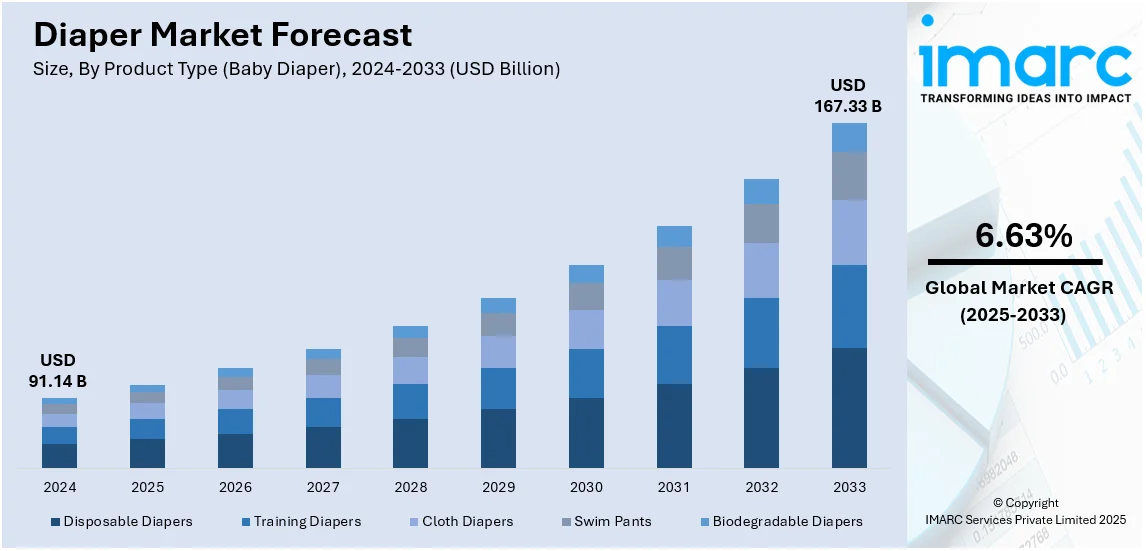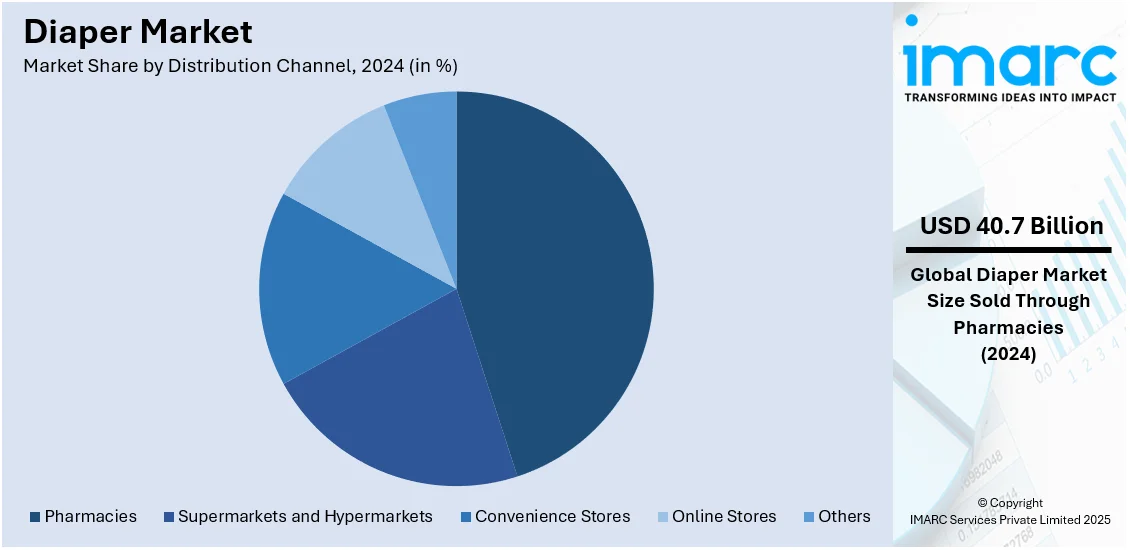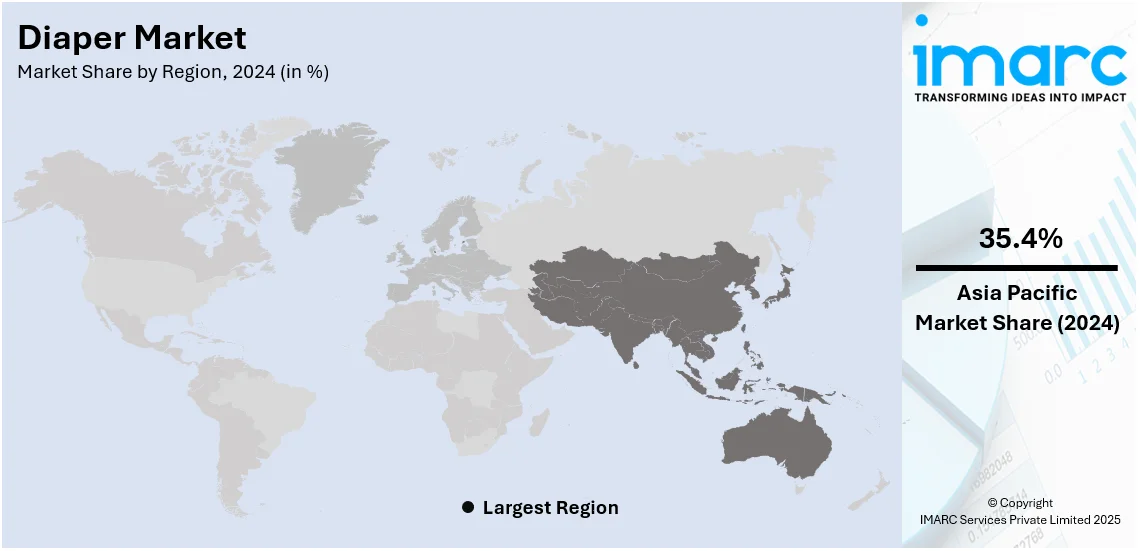
Diaper Market Size, Share, Trends and Forecast by Product Type (Baby Diaper), Product Type (Adult Diaper), Distribution Channel, and Region, 2025-2033
Diaper Market Size and Share:
The global diaper market size was valued at USD 91.14 Billion in 2024. Looking forward, IMARC Group estimates the market to reach USD 167.33 Billion by 2033, exhibiting a CAGR of 6.63% from 2025-2033. Asia-Pacific currently dominates the market, holding a market share of over 35.4% in 2024. The market is growing due to rising demand for baby care and adult incontinence products, driven by urbanization, increasing hygiene awareness, and product innovations. The shift toward eco-friendly, biodegradable, and high-absorbency diapers is shaping consumer preferences. Growth in e-commerce and subscription-based models is enhancing accessibility, further boosting diaper market share globally.
|
Report Attribute
|
Key Statistics
|
|---|---|
|
Base Year
|
2024 |
|
Forecast Years
|
2025-2033
|
|
Historical Years
|
2019-2024
|
| Market Size in 2024 | USD 91.14 Billion |
| Market Forecast in 2033 | USD 167.33 Billion |
| Market Growth Rate 2025-2033 |
6.63%
|
The diaper market is expanding due to rising birth rates, increasing disposable income and growing awareness of infant hygiene. Urbanization and lifestyle changes are driving demand for convenient, high-absorbency, and skin-friendly diapers. The aging population is also fueling the market for adult incontinence products. Eco-friendly and biodegradable diaper options are gaining traction as sustainability concerns rise. For instance, in February 2025, Ontex Group launched its Dreamshields technology for baby diapers in Europe, enhancing leakage protection, comfort, and sustainability. This innovative design reduces CO2 emissions and plastic use while ensuring optimal dryness. Laurent Nielly emphasizes its balance of quality and affordability, addressing modern families' needs for eco-friendly solutions. Additionally, the growth of e-commerce and innovations in absorbent materials are also creating a positive diaper market outlook across the world.

The United States diaper market is driven by rising demand for premium, high-absorbency diapers and increasing awareness of infant hygiene and skin health. The growing elderly population is fueling demand for adult incontinence products, supported by improved healthcare access. According to the data published by Population Reference Bureau, the U.S. population aged 65+ is projected to rise from 58 million in 2022 to 82 million by 2050, increasing their share from 17% to 23%. Sustainability concerns are driving the adoption of biodegradable and eco-friendly diapers, influencing consumer preferences. Additionally, the growth of e-commerce and subscription-based diaper services is making products more accessible, while technological advancements in absorbent materials are enhancing comfort and performance.
Diaper Market Trends:
Increase in birth rates
One of the primary factors expanding the diaper market size is an increase in birth rates, especially in developing countries. A rising population naturally translates to a higher number of infants, thereby boosting the need for baby care products, including diapers. Governments and healthcare organizations are also promoting better hygiene practices for infants, which adds to the overall sales. According to UNICEF, the number of children living in urban areas is projected to rise by 33%, with nearly 60% of children globally expected to reside in urban settings by 2050. The growing awareness about the advantages of using disposable diapers over traditional cloth variants, such as convenience and improved hygiene, also plays a significant role.
Rise in health and wellness awareness
There has been a growing focus on infant health and wellness. Parents today are more educated about the potential risks of diaper rash and the importance of good hygiene, due to the easily accessible information on the internet and advice from healthcare providers. As a result, there is an increased demand for diapers that are made from hypoallergenic, organic, or otherwise sensitive-skin-friendly materials. According to reports, the estimated spending level for children aged 0-3 is USD 54.99 Billion, reflecting the rising expenditure on premium baby care products, including high-quality diapers. This has given rise to a niche but rapidly growing market segment, further driving overall diaper market demand.
Growing e-commerce industry
The surge in online shopping has made it easier for consumers to purchase diapers. E-commerce platforms offer the convenience of home delivery, a wide range of product options, and often, more competitive prices than brick-and-mortar stores. These factors encourage parents to stock up on diapers, thereby driving demand. According to IMARC Group, the global e-commerce market size reached USD 26.8 Trillion in 2024 and is expected to reach USD 214.5 Trillion by 2033, exhibiting a CAGR of 25.83% during 2025-2033. The easy availability of product reviews and recommendations online also guides consumer choices, which enhances trust and consequently demand for these products.
Diaper Industry Segmentation:
IMARC Group provides an analysis of the key trends in each segment of the global diaper market, along with forecast at the global, regional, and country levels from 2025-2033. The market has been categorized based on product type (baby diaper), product type (adult diaper) and distribution channel.
Analysis by Product Type (Baby Diaper):
- Disposable Diapers
- Training Diapers
- Cloth Diapers
- Swim Pants
- Biodegradable Diapers
Disposable diapers stand as the largest product type (baby diaper) in 2024, holding around 61.6% of the market. According to the report, disposable diapers represented the largest segment. Disposable diapers are convenient and widely used option for parents and caregivers. These diapers are made from layers of synthetic materials that are highly absorbent, designed to draw moisture away from the skin of the babies. They are easy to put on and take off and can be simply discarded after use. This makes them particularly useful for outings or situations where washing a cloth diaper would be inconvenient.
Analysis by Product Type (Adult Diaper):
- Pad Type
- Flat Type
- Pant Type
Pad type leads the market with around 52.5% of market share in 2024. Pad type adult diapers are designed for individuals with moderate to light incontinence issues. They can be inserted into regular underwear to absorb leaks. They are made from layers of absorbent materials and are usually disposable and meant for one-time use. These pads are relatively discreet and are ideal for people who are mobile and can manage their incontinence with a less intrusive form of protection.
Analysis by Distribution Channel:

- Supermarkets and Hypermarkets
- Pharmacies
- Convenience Stores
- Online Stores
- Others
Pharmacies leads the market with around 44.7% of market share in 2024. Pharmacies play a crucial role in the diaper market, serving as a primary distribution channel for infant and adult incontinence products. Consumers prefer pharmacies for their trusted brands, availability of medical-grade diapers, and expert recommendations. The growing demand for adult diapers due to an aging population has further strengthened pharmacy sales. Additionally, pharmacies offer loyalty programs, home delivery, and bulk purchase options, making them a preferred choice. Their accessibility and association with healthcare drive their leadership in the diaper market.
Regional Analysis:

- North America
- United States
- Canada
- Asia Pacific
- China
- Japan
- India
- South Korea
- Australia
- Indonesia
- Others
- Europe
- Germany
- France
- United Kingdom
- Italy
- Spain
- Russia
- Others
- Latin America
- Brazil
- Mexico
- Others
- Middle East and Africa
In 2024, Asia-Pacific accounted for the largest market share of 35.4%. The Asia-Pacific region dominates the diaper market, driven by high birth rates, rising disposable income, and increasing urbanization. Growing awareness of infant hygiene and the rising demand for premium, high-absorbency diapers are fueling market growth. The expanding elderly population is also driving demand for adult incontinence products. Additionally, the rapid growth of e-commerce and retail networks is improving product accessibility. The shift towards eco-friendly and biodegradable diapers is further shaping the region’s dominance in the global diaper market.
Key Regional Takeaways:
North America Diaper Market Analysis
The North America diaper market is experiencing steady growth, driven by the rising demand for baby and adult incontinence products. Increasing awareness about hygiene, convenience, and product innovations is fueling market expansion. The growing elderly population and the prevalence of urinary incontinence are driving demand for high-absorbency and skin-friendly adult diapers. Parents are increasingly opting for premium, eco-friendly, and biodegradable baby diapers that offer enhanced comfort and leak protection. The rise of online retail and subscription-based diaper services is improving accessibility and convenience for consumers. Additionally, innovations in biodegradable materials and sustainable production methods are shaping purchasing preferences. Private-label diaper brands are gaining traction as cost-conscious consumers seek high-quality yet affordable alternatives. With increasing consumer preference for sustainable and dermatologically tested products, the North America diaper market is expected to witness sustained growth in the coming years.
United States Diaper Market Analysis
In 2024, the United States accounted for 88.50% of the diaper market in North America. The United States diaper market is witnessing steady growth, driven by increasing demand for baby care and adult incontinence products. Rising awareness regarding hygiene, convenience, and product innovations is fueling market expansion. The growing aging population and increasing cases of urinary incontinence are supporting the demand for adult diapers. The rising cost of infant care services is further contributing to the demand for baby diapers, as parents seek reliable and high-quality hygiene products. According to reports, federal and state early learning opportunities serve more than 4.2 million children and families, while 65% of children aged five and under have all available parents in the workforce. With the average price of center-based infant care reaching USD 1,188 per month, many families are prioritizing cost-effective yet high-quality diaper solutions to manage childcare expenses. Manufacturers are introducing eco-friendly, biodegradable, and premium diapers with enhanced absorbency and skin-friendly materials. The rise of online retail channels and subscription-based services is further boosting product accessibility. With growing consumer preference for sustainable and comfortable products, the U.S. diaper market is expected to expand steadily in the coming years.
Europe Diaper Market Analysis
The Europe diaper market is growing, supported by rising demand for high-quality and sustainable hygiene products. Increasing awareness about infant hygiene and elderly care is driving the adoption of baby and adult diapers across the region. The expanding geriatric population plays a crucial role in boosting demand for adult incontinence products, as older individuals increasingly require hygiene solutions for managing age-related health conditions. According to reports, as of January 2024, more than one-fifth (21.6%) of the EU population was aged 65 years and over, further highlighting the rising need for adult diapers. The growing popularity of biodegradable and organic diapers is shaping the market, driven by consumers' preference for eco-friendly products. Additionally, manufacturers are introducing innovative diaper solutions with improved absorbency, comfort, and skin-friendliness. With ongoing product innovations and the growing emphasis on sustainable hygiene solutions, the Europe diaper market is expected to witness consistent growth in the coming years.
Latin America Diaper Market Analysis
The Latin America diaper market is witnessing moderate growth, driven by increasing awareness about hygiene products and rising birth rates. The demand for baby diapers is primarily supported by young populations and improving living standards in the region. According to IMARC Group, Brazil's baby care products market size reached USD 6.12 Billion in 2024 and is expected to reach USD 11.06 Billion by 2033, exhibiting a CAGR of 6.30% during 2025-2033. This growth highlights the rising consumer spending on infant care products, including diapers. Additionally, the growing adoption of adult incontinence products due to the rising elderly population is contributing to market expansion. Manufacturers are introducing cost-effective and eco-friendly diapers to meet evolving consumer preferences.
Middle East and Africa Diaper Market Analysis
The Middle East and Africa diaper market is experiencing gradual growth, driven by the rising demand for baby and adult diapers due to increasing birth rates and growing awareness about hygiene and healthcare products. The expanding e-commerce sector is playing a crucial role in market expansion, offering consumers greater access to a wide range of diaper products. According to IMARC Group, Saudi Arabia's e-commerce market size reached USD 222.9 Billion in 2024 and is expected to exhibit a CAGR of 12.8% during 2025-2033, further supporting the availability of disposable hygiene products through online platforms. The market is expected to grow due to increased availability of hygiene products, urbanization, and evolving consumer preferences.
Competitive Landscape:
The diaper market is highly competitive, with global and regional players competing through product innovation, sustainability initiatives, and strategic partnerships. Leading manufacturers are focusing on eco-friendly, biodegradable, and high-absorbency diapers to cater to evolving consumer preferences. Companies are investing in research and development to enhance skin-friendliness, leak protection, and comfort. Private-label brands are gaining traction, offering cost-effective alternatives. The rise of subscription-based services and online retail channels is intensifying competition, enabling companies to expand their reach. Additionally, mergers, acquisitions, and collaborations with healthcare providers and retailers are key strategies to strengthen market presence and customer loyalty.
The report provides a comprehensive analysis of the competitive landscape in the diaper market with detailed profiles of all major companies, including:
- Kao Corporation
- Kimberly-Clark Corporation
- Procter & Gamble Company
- Svenska Cellulosa Aktiebolaget (SCA)
- Unicharm Corporation
Latest News and Developments:
- October 2024: Kimberly-Clark launched the Huggies Eco Protect hybrid diaper in Brazil. This diaper combines a washable fabric diaper with a disposable absorbent pad, reducing environmental waste by up to 28%. The line also included plant-based materials and natural fibers, offering sustainable baby care without compromising quality and protection.
- May 2024: Procter & Gamble's Pampers launched Swaddlers 360 diapers in 2024, featuring a 360-degree pull-on waistband and Easy-Tear Sides for convenient diaper changes. The diapers offer 100% leakproof protection, hypoallergenic materials, and enhanced skin protection, reinforcing P&G's commitment to innovation in baby care.
- March 2024: Merries launched its New & Improved Diapers in Malaysia, featuring superior breathability, long-lasting comfort, and superb absorbency. Hosted by Kao Malaysia, the event highlighted Merries' commitment to baby care innovation, offering parents a blend of comfort, convenience, and quality.
- March 2023: Procter & Gamble Company introduced a new P864-million Pamper diapers manufacturing line in Cabuyao, Laguna.
- January 2023: Kimberly-Clark Corporation recently relaunched its iconic diaper brand, Huggies, with the new ‘Huggies Complete Comfort’ range in India.
Diaper Market Report Scope:
| Report Features | Details |
|---|---|
| Base Year of the Analysis | 2024 |
| Historical Period | 2019-2024 |
| Forecast Period | 2025-2033 |
| Units | Billion USD |
| Scope of the Report | Exploration of Historical Trends and Market Outlook, Industry Catalysts and Challenges, Segment-Wise Historical and Predictive Market Assessment:
|
| Product Types (Baby Diaper) Covered | Disposable Diapers, Training Diapers, Cloth Diapers, Swim Pants, Biodegradable Diapers |
| Product Types (Adult Diapers) Covered |
Pad Type, Flat Type, Pant Type |
| Distribution Channels Covered | Supermarkets and Hypermarkets, Pharmacies, Convenience Stores, Online Stores, Others |
| Regions Covered | Asia Pacific, Europe, North America, Latin America, Middle East and Africa |
| Countries Covered | United States, Canada, Germany, France, United Kingdom, Italy, Spain, Russia, China, Japan, India, South Korea, Australia, Indonesia, Brazil, Mexico |
| Companies Covered | Kao Corporation, Kimberly-Clark Corporation, Procter & Gamble Company, Svenska Cellulosa Aktiebolaget (SCA), Unicharm Corporation, etc. |
| Customization Scope | 10% Free Customization |
| Post-Sale Analyst Support | 10-12 Weeks |
| Delivery Format | PDF and Excel through Email (We can also provide the editable version of the report in PPT/Word format on special request) |
Key Benefits for Stakeholders:
- IMARC’s report offers a comprehensive quantitative analysis of various market segments, historical and current market trends, market forecasts, and dynamics of the diaper market from 2019-2033.
- The research study provides the latest information on the market drivers, challenges, and opportunities in the global diaper market.
- The study maps the leading, as well as the fastest-growing, regional markets. It further enables stakeholders to identify the key country-level markets within each region.
- Porter's Five Forces analysis assists stakeholders in assessing the impact of new entrants, competitive rivalry, supplier power, buyer power, and the threat of substitution. It helps stakeholders to analyze the level of competition within the diaper industry and its attractiveness.
- Competitive landscape allows stakeholders to understand their competitive environment and provides an insight into the current positions of key players in the market.
Key Questions Answered in This Report
The diaper market was valued at USD 91.14 Billion in 2024.
IMARC estimates the diaper market to reach USD 167.33 Billion by 2033, exhibiting a CAGR of 6.63% from 2025-2033.
The diaper market is driven by rising birth rates, increasing elderly population, and growing awareness of hygiene and infant care. Demand for eco-friendly, biodegradable, and high-absorbency diapers is rising. E-commerce expansion, product innovations, and premium diaper offerings further contribute to market growth.
Asia-Pacific holds the largest diaper market share, driven by high birth rates, rising disposable income, and increasing urbanization. Growing awareness of infant hygiene and adult incontinence care, along with the expansion of e-commerce and retail networks, is fueling the demand for premium, high-absorbency, and eco-friendly diapers in the region.
Some of the major players in the diaper market include Kao Corporation, Kimberly-Clark Corporation, Procter & Gamble Company, Svenska Cellulosa Aktiebolaget (SCA), Unicharm Corporation, etc.
Need more help?
- Speak to our experienced analysts for insights on the current market scenarios.
- Include additional segments and countries to customize the report as per your requirement.
- Gain an unparalleled competitive advantage in your domain by understanding how to utilize the report and positively impacting your operations and revenue.
- For further assistance, please connect with our analysts.
 Inquire Before Buying
Inquire Before Buying
 Speak to an Analyst
Speak to an Analyst
 Request Brochure
Request Brochure
 Request Customization
Request Customization




.webp)




.webp)












